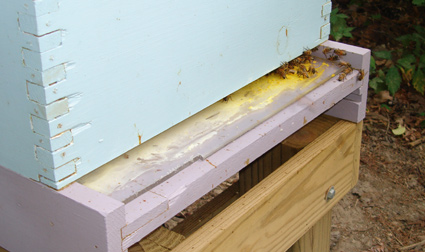2:1 Sugar Helps the Medicine Go Down
At the beginning of the year, my dad and I decided we'd both use different methods of delivering sugar syrup to the bees so we could learn the pros/cons of each method.
As it turns out, I like the jar method for short feeding cycles, but I like the hive top feeder even more. I think the bees are able to get syrup faster than any other method since there's so much more open surface room.
I liked it so much, I built one myself.
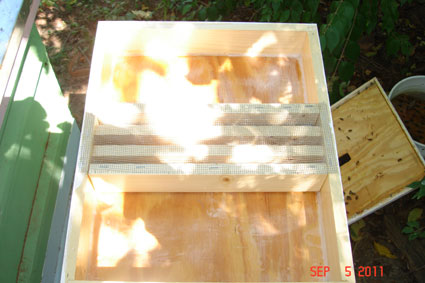
I built the feeder this past weekend since the white hive, that I'm still waiting to see if their attempt to produce their own replacement queen worked or not, is in need of help before winter arrives.
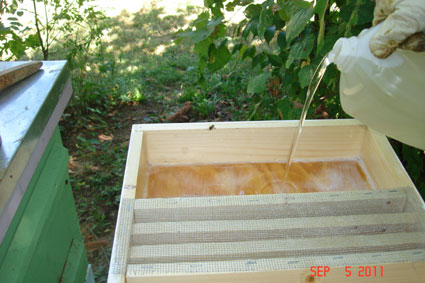
Their entire lower brood box is almost empty of stores, and their top box is only half full. I want them to take syrup, and fast.
In the mix of 2:1 syrup, I added Spearmint and lemongrass essential oils. These two oils are said to help naturally control mites and pests in the hive. Since we aren't using any purchased chemicals or pesticides in our hives, we thought we'd try these essential oils and see how they worked.
In addition to the essential oils in the 2:1 syrup, we put down these tracking strips. I haven't heard of these before, but when I read about them, they make a lot of sense!
Any type of treatment in the syrup requires bees to drink the syrup to have any effect. Grease patties are quick and easy (and I'm using them) but again, it only helps the bees who eat the patties.
The concept of the tracking strips is that you smear a slurry of oils onto a Plexiglas strip, and lay that strip on the landing board. As bees come and go, they track their feet and bodies through the slurry. Since every bee in the hive eventually has to leave for...ehem..cleansing flights...bingo- you've just treated every bee.
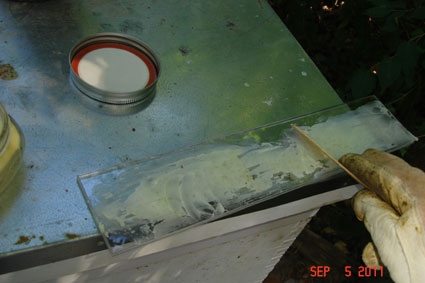
Now I simply place the Plexiglas onto the landing board, slowly moving it to the inside of the hive, allowing bees who are on the landing board time to move out of the way.
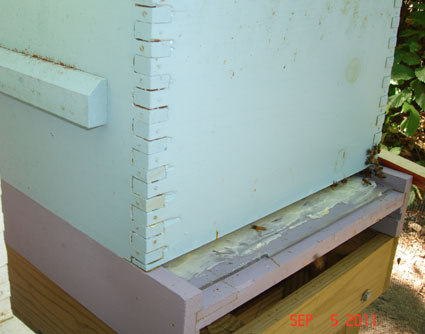
I decided to leave a little stick out so that I'd have a way to grab it easy and remove it later.
As it turns out, I like the jar method for short feeding cycles, but I like the hive top feeder even more. I think the bees are able to get syrup faster than any other method since there's so much more open surface room.
I liked it so much, I built one myself.

I built the feeder this past weekend since the white hive, that I'm still waiting to see if their attempt to produce their own replacement queen worked or not, is in need of help before winter arrives.

Their entire lower brood box is almost empty of stores, and their top box is only half full. I want them to take syrup, and fast.
In the mix of 2:1 syrup, I added Spearmint and lemongrass essential oils. These two oils are said to help naturally control mites and pests in the hive. Since we aren't using any purchased chemicals or pesticides in our hives, we thought we'd try these essential oils and see how they worked.
In addition to the essential oils in the 2:1 syrup, we put down these tracking strips. I haven't heard of these before, but when I read about them, they make a lot of sense!
Any type of treatment in the syrup requires bees to drink the syrup to have any effect. Grease patties are quick and easy (and I'm using them) but again, it only helps the bees who eat the patties.
The concept of the tracking strips is that you smear a slurry of oils onto a Plexiglas strip, and lay that strip on the landing board. As bees come and go, they track their feet and bodies through the slurry. Since every bee in the hive eventually has to leave for...ehem..cleansing flights...bingo- you've just treated every bee.
The slurry is made as follows: 17.5 ozs. (2 and 1/5 cups)
of canola oil mixed with
6.5 ozs. (slightly more than 4/5 cup) of melted beeswax, stirred and set
on a hot plate or the stove to keep warm. To this
liquid add 24 cc's of wintergreen oil (or 24 cc's of
patchouli oil or 12 cc's of each ). Stir well and
pour into three 8 oz. containers.
When cooled, the slurry has a shoe-polish or salve-like consistency.
Then, 2 to 3 teaspoons of the slurry is applied to the tracking strip which is placed just inside the front entrance of each colony. The bees must track through this slurry when they enter or exit the hive; they then clean off the slurry by eating it and feeding it to each other. Treatments are repeated after 5 days: the old slurry, dead mites and dead, deformed bees are scraped off and new slurry added.
Plexiglas is used for tracking strips because it has a very smooth finish allowing an even coverage and it is too hard for the bees to chew up or remove; masonite or other similar material could be used just as well. (Varroa Mite Control, 1996 wvu.edu)
You can see in the pictures below, the cut of Plexiglas, and me smearing the slurry.When cooled, the slurry has a shoe-polish or salve-like consistency.
Then, 2 to 3 teaspoons of the slurry is applied to the tracking strip which is placed just inside the front entrance of each colony. The bees must track through this slurry when they enter or exit the hive; they then clean off the slurry by eating it and feeding it to each other. Treatments are repeated after 5 days: the old slurry, dead mites and dead, deformed bees are scraped off and new slurry added.
Plexiglas is used for tracking strips because it has a very smooth finish allowing an even coverage and it is too hard for the bees to chew up or remove; masonite or other similar material could be used just as well. (Varroa Mite Control, 1996 wvu.edu)

Now I simply place the Plexiglas onto the landing board, slowly moving it to the inside of the hive, allowing bees who are on the landing board time to move out of the way.

I decided to leave a little stick out so that I'd have a way to grab it easy and remove it later.
Comments For This Post: (2) | Post Your Comments! Hide The Comment Form
